"The historian or the antiquary may have traversed the fields of ancient or of modern battles, and may have pursued the line of march of triumphant conquerors, whose armies trampled down the most mighty kingdoms of the world. The winds and storms have utterly obliterated the ephemeral impressions in their course. Not a track remains of a single foot or a single hoof of all the countless millions of men and beasts whose progress spread desolation over the earth.
But the reptiles that crawled upon the half-finished surface of our infant planet have left memorials of their passage, enduring and indelible. Centuries and thousands of years have rolled away, between the time in which these footsteps were impressed upon the sands of their native Scotland, and the hour when they were again laid bare and exposed to our curious and admiring eyes.
Yet we behold them stamped upon the rock, distinct as the track of the passing animal upon the recent snow; as if to show that thousands of years are but as nothing amidst eternity, and, as it were, in mockery of the fleeting perishable course of the mightiest potentates among mankind."
[Professor William Buckland* in an address to the Geological Society; sometime before 1856]
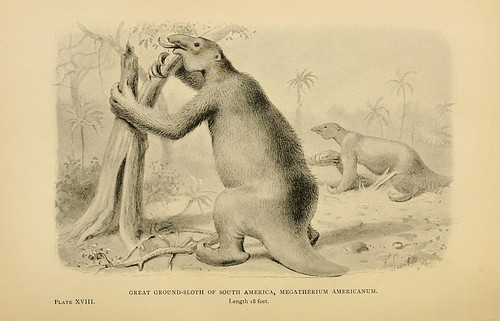
Great Ground-Sloth of South America, Megatherium americanum
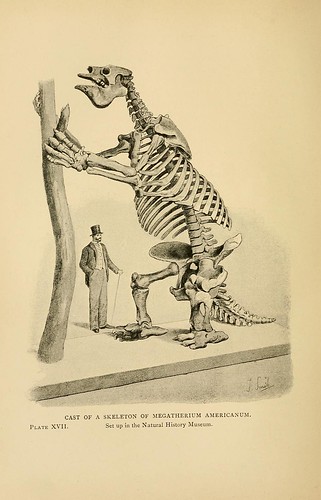
Cast of a Skeleton of Megatherium americanum
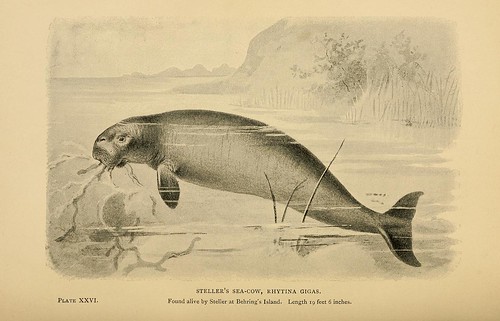
Steller's Sea-Cow, Rhytina gigas

Fish-Lizards

Group of Sea-Serpents, Elasmosaur, and Fishes

Long-necked Sea-Lizard
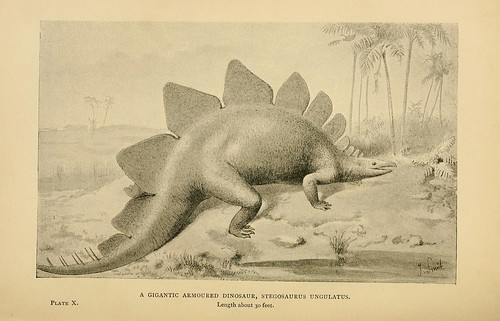
A Gigantic Armoured Dinosaur, Stegosaurus ungulatus
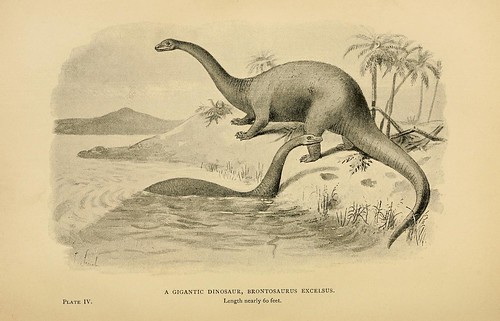
A Gigantic Dinosaur, Brontosaurus excelsus
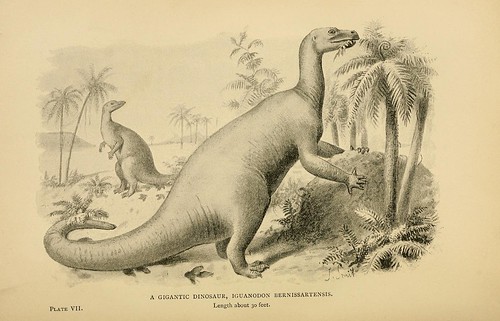
A Gigantic Dinosaur, Iguanadon bernissatenses
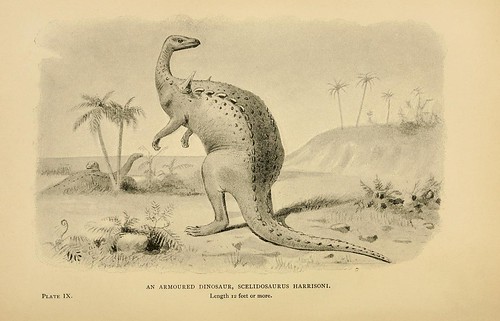
An Armoured Dinosaur, Scelidosaurus harrisoni
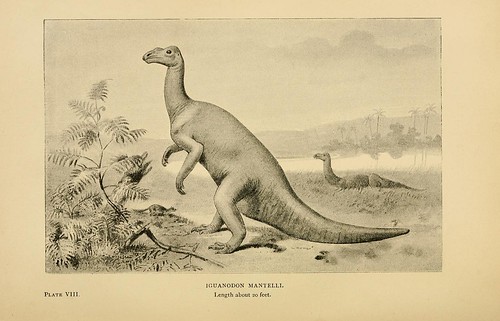
Igauanadon mantelli
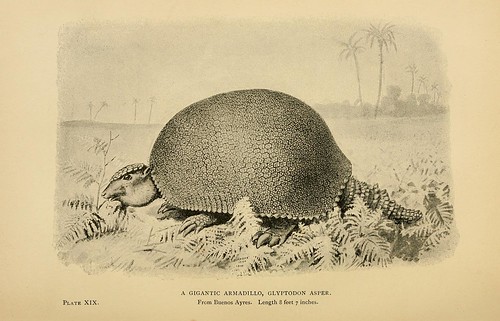
A Gigantic Armadillo, Gyptodon asper

A Huge Extinct Mammal from North America. Brontops robustus

The Great Irish Deer, Cervus megaceros
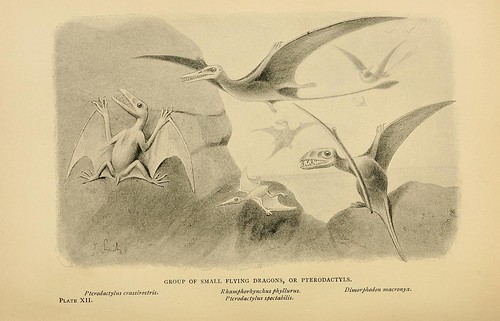
Group of Small Flying Dragons, or Pterodactyls

Moa-Birds
'Extinct Monsters; a Popular Account of Some of the Larger Forms of Ancient Animal Life' was first published in 1893 by Reverend HN Hutchinson, featuring illustrations by the respected wildlife artist, Joseph Smit (& others).
The images above - spot cleaned - come from the 4th edition, published in 1896 and recently uploaded by Harvard to the Biodiversity website (there are various ways to see the book, including a new 'Alternate page viewer': found by mousing over 'Download/about this book' link). Other editions of this very popular book can be found at the Internet Archive and Googlebooks. {nb. There are more images from the book in the set}
Contemporary reviews spoke well of the publication (see for instance the New York Times account from 1893). It was a fairly dispassionate but very readable work that relied on the most up to date scientific findings to hand and Hutchinson, to his credit, refrained from hyping the novelty aspect of a subject that was still newly fascinating for the general population.
Below is the complete transcription of a review of 'Extinct Monsters' that appeared in the 'Literary Notices' section in Volume 43 of the periodical: Popular Science Monthly [1893] {here or here}:
"The object of this book is twofold: to describe some of the larger and more monstrous forms of the past, and endeavor by pen and pencil to present them as they were in life and to illustrate how in animal life the past has grown into the present without the long and abrupt leaps which we are too liable to regard as one of the chief features of the transition. Stress is laid upon the quality of the illustrations. They are still to a certain extent conjectural, but they rest upon larger and more accurate information than any portraits of the giants and dragons of old that have previously appeared.
Many of the former pictures of these creatures were highly sensational; in some of the later ones neither art nor Nature had fair play, and we had to put up with awkward-looking creatures that could not get along at all in life, or with animals in attitudes which later researches have shown were not theirs. Hence our ideas upon these points need to be revised. The discoveries of later years have shown, as Dr. Henry Woodward observes in the preface he furnishes, "that the dicynodon and labyrinthodon, instead of being toadlike in form, were lacertilian or salamander-like reptiles, with elongated bodies and moderately long tails; that the iguanodon did not usually stand upon 'all fours', but more frequently sat up like some huge kangaroo with short fore limbs."
The discoveries of Marsh, Cope, Leidy, and others in America have added vastly to our knowledge of the real structure of these animals. We have now almost complete skeletons and details of the flying membranes of long and short tailed pterodactyles ; the archaeopteryx and Marsh's hesperomis and ichthyomis have given more definite shape to our knowledge of primitive birds; and the discovery by Prof. Fraas of the outlines of the skin and fins of ichthyosaurus have established the pertinency of the term fish-lizard as applied to it.
These and other discoveries have been applied in the text and illustrations of this book; and we have, accordingly, the saurians of the sea and the land, the real dragons and sea-serpents of old, the monsters of America and of India — mega- theriums, glyptodons, mastodon, mammoth, giant birds, Irish elk, and Steller's sea cow — represented with a clearer approach to accuracy than ever before, but still subject to correction by future discoveries."
For more in the way of popular illustrations (and photographs) relating to prehistoric creatures see:
- Norman Felchle's Flickr stream.
- The dinosaurs! group pool on Flickr.
- Old Dinosaur Books.
- Vintage Dinosaur Books.
In a general sense also see:
- 'Extinct Birds' by LW Rothschild, 1907 among the fabulous University of Wisconsin Digital Collections. (which remains, to my mind, the best repository site online, bar none)
- Laelaps blog and sidebar links.



















7 comments :
And which of the above left their footprints "upon the sands of their native Scotland," I should like to know?
Very fine sloth(liness) and I am glad to know moas are not being neglected.
I don't recall if you ever took a look at the dinosaurs here!
Smashing stuff!
How do you go about getting your books?
I am so glad that sea-cows are not extinct!!
weirdimals, there's only one BibliOdyssey book. The publisher's site and a few related links were folded into the announcement post.
Thanks Karla. Heh. That dinosaur doesn't really look like he's "resting" next to the theatre. Did you ever get the scans of Hašek's collages??
I believe we can safely say that the dinosaur is "embracing" the theater. Perhaps it had a passion for historicist architecture, or for Czech nationalism. (Strangely enough, I am rather ignorant about saurian emotional attachments or favorite fetishes.)
Alas, the scans never arrived. I'll have to look for the collages myself next time I'm in Prague.
And, like Shannon, I'm glad sea cows aren't extinct. This reminds me I've got to ask my brother to refresh my memory on a story he once told me of someone who resembled one. I believe it was someone who gave a conference paper, but I'm not certain. It was some sort of large, whiskery academic.
I really like these images. I think of the first movies about dinosaurs. With special effects of Willis O'Brien and Ray Harryhausen.
Saludos.
Post a Comment
Comments are all moderated so don't waste your time spamming: they will never show up.
If you include ANY links that aren't pertinent to the blog post or discussion they will be deleted and a rash will break out in your underwear.
Also: please play the ball and not the person.
Note: only a member of this blog may post a comment.